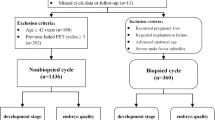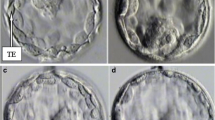Abstract
Purpose: To investigate the cleavage stage embryo quality by the correlation between the morphological features and blastocyst development rate to develop a new embryo grading system.
Methods: A retrospective analysis, including 216 cycles of cleavage stage embryo transfer and 251 cycles of blastocyst transfer. The correlation with blastocyst development of the embryo cleavage stage, fragmentation and uniformity of blastomeres was evaluated.
Results: There were significant differences in the blastocyst development rate between ≥7 cells and ≤6 cells (68.8% vs. 30.7%), <50% fragmentation and ≥50% fragmentation (51.9% vs. 25.7%), and evenly sized blastomeres and unevenly sized blastomeres (48.7% vs. 30.1%) on day 3. The new grading system defined by these 3 parameters showed a preferable correlation to the pregnancy rate.
Conclusions: The new grading system specific for day 3 embryos is useful for the selection of good quality embryos and may improve the pregnancy rate.





Similar content being viewed by others
References
Puissant F, Van Rysselberge M, Barlow P, Deweze J, Leroy F. Embryo scoring as a prognostic tool in IVF treatment. Hum Reprod 1987;2:705–8
Cummins JM, Breen TM, Harrison KL, Shaw JM, Wilson LM, Hennessey JF. A formula for scoring human embryo growth rates in in vitro fertilization: its value in predicting pregnancy and in comparison with visual estimates of embryo quality. J In Vitro Fert Embryo Transf 1986;3:284–95
Veeck LL. Oocyte assessment and biological performance. Ann N Y Acad Sci 1988;541:259–74
Ziebe S, Petersen K, Lindenberg S, Andersen AG, Gabrielsen A, Andersen AN. Embryo morphology or cleavage stage: how to select the best embryos for transfer after in-vitro fertilization. Hum Reprod 1997;12:1545–49
Gardner DK, Schoolcraft WB, Wagley L, Schlenker T, Stevens J, Hesla J. A prospective randomized trial of blastocyst culture and transfer in in-vitro fertilization. Hum Reprod 1998;13:3434–40
Gardner DK, Vella P, Lane M, Wagley L, Schlenker T, Schoolcraft WB. Culture and transfer of human blastocysts increases implantation rates and reduces the need for multiple embryo transfers. Fertil Steril 1998;69:84–8
Schwarzler P, Zech H, Auer M, Pfau K, Gobel G, Vanderzwalmen P, Zech N. Pregnancy outcome after blastocyst transfer as compared to early cleavage stage embryo transfer. Hum Reprod 2004;19:2097–102
Milki AA, Fisch JD, Behr B. Two-blastocyst transfer has similar pregnancy rates and a decreased multiple gestation rate compared with three-blastocyst transfer. Fertil Steril 1999;72:225–28
Gardner DK, Lane M, Stevens J, Schlenker T, Schoolcraft WB. Blastocyst score affects implantation and pregnancy outcome: towards a single blastocyst transfer. Fertil Steril 2000;73:1155–8
Hreinsson J, Rosenlund B, Fridstrom M, Ek I, Levkov L, Sjoblom P, Hovatta O. Embryo transfer is equally effective at cleavage stage and blastocyst stage: a randomized prospective study. Eur J Obstet Gynecol Reprod Biol 2004;117:194–200
Kondo I, Suganuma N, Ando T, Asada Y, Furuhashi M, Tomoda Y. Clinical factors for successful cryopreserved-thawed embryo transfer. J Assist Reprod Genet 1996;13:201–6
Shoukir Y, Campana A, Farley T, Sakkas D. Early cleavage of in-vitro fertilized human embryos to the 2-cell stage: a novel indicator of embryo quality and viability. Hum Reprod 1997;12:1531–36
Sakkas D, Shoukir Y, Chardonnens D, Bianchi PG, Campana A. Early cleavage of human embryos to the two-cell stage after intracytoplasmic sperm injection as an indicator of embryo viability. Hum Reprod 1998;13:182–7
Baczkowski T, Kurzawa R, Glabowski W. Methods of embryo scoring in in vitro fertilization. Reprod Biol 2004;4:5–22
Gardner DK, Sakkas D. Assessment of embryo viability: the ability to select a single embryo for transfer–a review. Placenta 2003;24(Suppl B):S5–12
Veeck LL. An atlas of human gametes and conceptuses. An illustrated reference for assisted reproductive technology; 1999
Van Royen E, Mangelschots K, De Neubourg D, Valkenburg M, Van de Meerssche M, Ryckaert G, Eestermans W, Gerris J. Characterization of a top quality embryo, a step towards single-embryo transfer. Hum Reprod 1999;14:2345–49
Gerris J, De Neubourg D, Mangelschots K, Van Royen E, Van de Meerssche M, Valkenburg M. Prevention of twin pregnancy after in-vitro fertilization or intracytoplasmic sperm injection based on strict embryo criteria: a prospective randomized clinical trial. Hum Reprod 1999;14:2581–87
Iwase A, Ando H, Kuno K, Mizutani S. Use of follicle-stimulating hormone test to predict poor response in in vitro fertilization. Obstet Gynecol 2005;105:645–52
Schnorr JA, Doviak MJ, Muasher SJ, Jones HW, Jr. Impact of a cryopreservation program on the multiple pregnancy rate associated with assisted reproductive technologies. Fertil Steril 2001;75:147–51
Guidelines on the number of embryos transferred. Fertil Steril 2004;82:773–4
Thurin A, Hausken J, Hillensjo T, Jablonowska B, Pinborg A, Strandell A, Bergh C. Elective single-embryo transfer versus double-embryo transfer in in vitro fertilization. N Engl J Med 2004;351:2392–2402
Jones GM, Trounson AO. Blastocyst stage transfer: pitfalls and benefits. The benefits of extended culture. Hum Reprod 1999;14:1405–8
Benkhalifa M, Menezo Y, Janny L, Pouly JL, Qumsiyeh MB. Cytogenetics of uncleaved oocytes and arrested zygotes in IVF programs. J Assist Reprod Genet 1996;13:140–8
Unger S, Hoopmann M, Bald R, Foth D, Nawroth F. Monozygotic triplets and monozygotic twins after ICSI and transfer of two blastocysts: case report. Hum Reprod 2004;19:110–3
da Costa AA, Abdelmassih S, de Oliveira FG, Abdelmassih V, Abdelmassih R, Nagy ZP, Balmaceda JP. Monozygotic twins and transfer at the blastocyst stage after ICSI. Hum Reprod 2001;16:333–6
Peramo B, Ricciarelli E, Cuadros-Fernandez JM, Huguet E, Hernandez ER. Blastocyst transfer and monozygotic twinning. Fertil Steril 1999;72:1116–17
Blake D, Proctor M, Johnson N, Olive D. Cleavage stage versus blastocyst stage embryo transfer in assisted conception. Cochrane Database Syst Rev 2005:CD002118
Hsu MI, Mayer J, Aronshon M, Lanzendorf S, Muasher S, Kolm P, Oehninger S. Embryo implantation in in vitro fertilization and intracytoplasmic sperm injection: impact of cleavage status, morphology grade, and number of embryos transferred. Fertil Steril 1999;72:679–85
Alikani M, Cohen J, Tomkin G, Garrisi GJ, Mack C, Scott RT. Human embryo fragmentation in vitro and its implications for pregnancy and implantation. Fertil Steril 1999;71:836–42
Alikani M, Calderon G, Tomkin G, Garrisi J, Kokot M, Cohen J. Cleavage anomalies in early human embryos and survival after prolonged culture in-vitro. Hum Reprod 2000;15:2634–43
Magli MC, Jones GM, Gras L, Gianaroli L, Korman I, Trounson AO. Chromosome mosaicism in day 3 aneuploid embryos that develop to morphologically normal blastocysts in vitro. Hum Reprod 2000;15:1781–6
Dennis SJ, Thomas MA, Williams DB, Robins JC. Embryo morphology score on day 3 is predictive of implantation and live birth rates. J Assist Reprod Genet 2006;23:171–5
Author information
Authors and Affiliations
Corresponding author
Rights and permissions
About this article
Cite this article
Nomura, M., Iwase, A., Furui, K. et al. Preferable correlation to blastocyst development and pregnancy rates with a new embryo grading system specific for day 3 embryos. J Assist Reprod Genet 24, 23–28 (2007). https://doi.org/10.1007/s10815-006-9086-5
Received:
Accepted:
Published:
Issue Date:
DOI: https://doi.org/10.1007/s10815-006-9086-5




